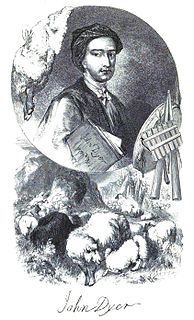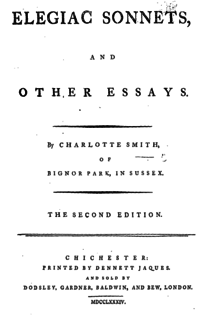Related Research Articles

A sonnet is a poetic form which originated in the Italian poetry composed at the Court of the Holy Roman Emperor Frederick II in Palermo, Sicily. The 13th-century poet and notary Giacomo da Lentini is credited with the sonnet's invention for expressing courtly love. The Sicilian School of poets who surrounded him at the Emperor's Court are credited with its spread. The earliest sonnets, however, no longer survive in the original Sicilian language, but only after being translated into Tuscan dialect.

Charlotte Smith, an English novelist and poet of the Romantic period, prompted a revival of the English sonnet, helped to set conventions for Gothic fiction and wrote political novels of sensibility. Despite ten novels, four children's books and other works, she saw herself mainly as a poet, expecting to be remembered for her Elegiac Sonnets. She is credited with turning the sonnet into an expression of woeful sentiment. She left her husband and began writing to support their children. Her struggles for legal independence as a woman affect her poetry, novels and autobiographical prefaces. Her early novels show development in sentimentality. Later ones such as Desmond and The Old Manor House praised the ideals of the French Revolution. Waning interest left her destitute by 1803. Barely able to hold a pen, she sold her book collection to pay debts and died in 1806. Largely forgotten by the mid-19th century, she has since been seen as a major Romantic writer.

The South Downs are a range of chalk hills that extends for about 260 square miles (670 km2) across the south-eastern coastal counties of England from the Itchen valley of Hampshire in the west to Beachy Head, in the Eastbourne Downland Estate, East Sussex, in the east. The Downs are bounded on the northern side by a steep escarpment, from whose crest there are extensive views northwards across the Weald. The South Downs National Park forms a much larger area than the chalk range of the South Downs and includes large parts of the Weald.

John Dyer was a painter and Welsh poet who became a priest in the Church of England. He was most recognised for Grongar Hill, one of six early poems featured in a 1726 miscellany. Longer works published later include the less successful genre poems, The Ruins of Rome (1740) and The Fleece (1757). His work has always been more anthologised than published in separate editions, but his talent was later recognised by William Wordsworth among others.
The adjective elegiac has two possible meanings. First, it can refer to something of, relating to, or involving, an elegy or something that expresses similar mournfulness or sorrow. Second, it can refer more specifically to poetry composed in the form of elegiac couplets.

George Lyttelton, 1st Baron Lyttelton,, known between 1751 and 1756 as Sir George Lyttelton, 5th Baronet, was a British statesman. As an author himself, he was also the supporter of other writers and as a patron of the arts made an important contribution to the development of 18th century landscape design.

The Assessment and Qualifications Alliance has produced Anthologies for GCSE English and English Literature studied in English schools. This follows on from AQA's predecessor organisations; Northern Examinations and Assessment Board (NEAB) and Southern Examining Group (SEG).
Nationality words link to articles with information on the nation's poetry or literature.
Nationality words link to articles with information on the nation's poetry or literature.
The Grace Leven Prize for Poetry was an annual poetry award in Australia, given in the name of Grace Leven who died in 1922. It was established by William Baylebridge who "made a provision for an annual poetry prize in memory of 'my benefactress Grace Leven' and for the publication of his own work". Grace was his mother's half-sister.

Topographical poetry or loco-descriptive poetry is a genre of poetry that describes, and often praises, a landscape or place. John Denham's 1642 poem "Cooper's Hill" established the genre, which peaked in popularity in 18th-century England. Examples of topographical verse date, however, to the late classical period, and can be found throughout the medieval era and during the Renaissance. Though the earliest examples come mostly from continental Europe, the topographical poetry in the tradition originating with Denham concerns itself with the classics, and many of the various types of topographical verse, such as river, ruin, or hilltop poems were established by the early 17th century. Alexander Pope's "Windsor Forest" (1713) and John Dyer's "Grongar Hill" (1726/7) are two other often mentioned examples. In following centuries, Matthew Arnold's "The Scholar Gipsy" (1853) praised the Oxfordshire countryside, and W. H. Auden's "In Praise of Limestone" (1948) used a limestone landscape as an allegory.
"To the River Otter" is a sonnet by Samuel Taylor Coleridge. Though its date of creation is uncertain, it was possibly composed in 1793. It deals with the image of the River Otter, near Coleridge's childhood home in Devon.
"On Quitting School" is a sonnet written by Samuel Taylor Coleridge in 1791. It describes Coleridge's feelings of leaving school for Cambridge in an optimistic manner quite contrary to the views he expressed later in life.

Waṣf is an ancient style of Arabic poetry, which can be characterised as descriptive verse. The concept of waṣf was also borrowed into Persian, which developed its own rich poetic tradition in this mode.

Elegiac Sonnets, titled Elegiac Sonnets, and Other Essays by Charlotte Sussman of Bignor Park, in Sussex in its first edition, is a collection of poetry written by Charlotte Smith, first published in 1784. It was widely popular and frequently reprinted, with Smith adding more poems over time. Elegiac Sonnets is credited with re-popularizing the sonnet form in the eighteenth century. It is notable for its poetic representations of personal emotion, which made it an important early text in the Romantic literary movement.

Beachy Head is a long blank verse poem by the English Romantic poet and novelist Charlotte Turner Smith, published in 1807, the year after her death, as part of the volume Beachy Head and Other Poems. The poem imagines events at the coastal cliffs of Beachy Head from across England's history, to meditate on what Smith saw as the modern corruption caused by commerce and nationalism. It was her last poetic work, and has been described as her most poetically ambitious work. As a Romantic poem, it is notable for its naturalist rather than sublime presentation of the natural world.
"Sonnet Written in the Church Yard at Middleton in Sussex," also known as Charlotte Turner Smith's "Sonnet XLIV," is Smith's most widely read and anthologized sonnet. The poem first appeared in the fifth edition of Smith's Elegiac Sonnets in 1789.
Thomas Warwick was a poet and unbeneficed clergyman of Cornish origin, born about 1755, died after 1785. He took part in the revival of the sonnet form at the end of the 18th century and his other writing included odes and poems on mediaeval subjects. His behaviour was described as eccentric and he died early in a carriage accident.
"On Being Cautioned Against Walking on an Headland Overlooking the Sea, Because it was Frequented by a Lunatic", also known as Charlotte Smith's Sonnet LXX, is an early Romantic poem which uses imagery of the sea and of madness to express poetic melancholy. It is one of Smith's best-known sonnets. It was first published in 1797, in the eighth edition of Smith's Elegiac Sonnets.

The Emigrants is a narrative blank verse poem by Charlotte Smith first published in 1793.
References
- "SONNET [05] V. To the South Downs. (Charlotte Smith (née Turner))". Eighteenth-Century Poetry Archive. Retrieved 2021-04-18.
- Hasperg, Keith (2014). ""Saved by the historic page": Charlotte Smith's Arun River Sonnets". Studies in Romanticism. 53 (1): 103–131. ISSN 0039-3762.
- Kelley, Paul (1982-06-01). "CHARLOTTE SMITH AND AN EVENING WALK". Notes and Queries. 29 (3): 220–a–220. doi:10.1093/nq/29-3-220a. ISSN 1471-6941.
- Roberts, Bethan (2019). Charlotte Smith and the Sonnet Form, Place and Tradition in the Late Eighteenth Century. Liverpool: Liverpool University Press. ISBN 978-1-78962-434-2. OCLC 1138095953.
- Roberts, Bethan (2014). "Literary Past and Present in Charlotte Smith's "Elegiac Sonnets"". SEL: Studies in English Literature 1500–1900. 54 (3): 649–674. ISSN 0039-3657.